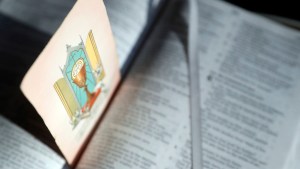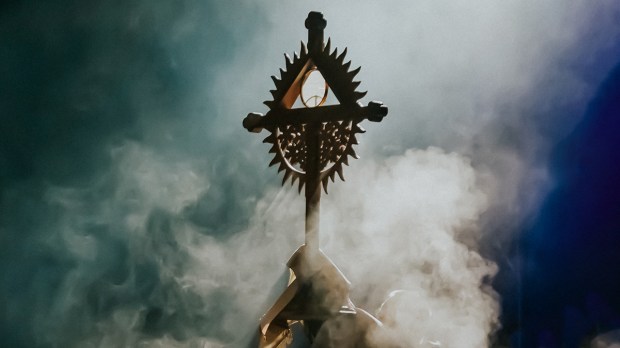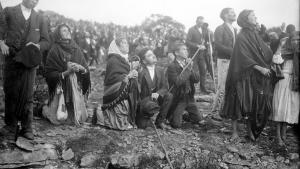Each year beginning in 1926, the famous English convert Msgr. Ronald Knox gave a homily on Corpus Christi Sunday at Corpus Christi Church (also called “the actor’s church”) in the heart of London. In one of his homilies, “First and Last Communion,” he asks the reader to imagine the last Mass that will be offered on earth:
Yesterday, today, and forever—cast your mind forward to the last Mass that will ever be said on earth. . . . Yes it will be the same in all essentials. . . .The language in which the vernacular prayers are said will be a language, perhaps, which the human race has not yet invented. The architecture of the church may be of a kind we can imagine as little as the holy apostles, say, could have imagined Westminster Abbey. The feast celebrated on that occasion may be the feast of some saint who will not be born for many years yet . . . in the consecration of that last Mass the Body and Blood of our Lord Jesus Christ will be no more and no less present, no more and no less powerful in its effects, than in the Mass you are hearing just now, or in that first Mass of the first Maundy Thursday.
This is not just an interesting imaginative exercise: past, present, and future have been at the core of the Eucharist since its institution by Christ at the Last Supper. Pondering these realities can increase our understanding of the Real Presence of Jesus in the Eucharist.
The future and the present in the Real Presence
Fr. Robert Spitzer, SJ—founder of the Magis Center and featured on EWTN’s Fr. Spitzer’s Universe—discusses the 1st-century Jewish view of time and memory in his article, “The Real Presence of Jesus.” There he reminds us that this view of time and memory is critical to an understanding of what Jesus intended when He celebrated the Passover meal with His disciples:
In this view, time is not an unalterable physical property (as in the “space-time continuum” of the Theory of Relativity). Rather, time was seen as a surmountable and controllable dimension of sacred history.
Religious authorities believed that the celebration of the Passover Supper was a return to the sacred events of the Exodus, and that reliving this sacred moment would bring them close to the sacred reality (God), which would, in turn, sacralize them—make them holy.
Fr. Spitzer then explains how Christ’s words made present His futuresacrifice on Calvary:
When He handed the bread to His apostles at table using the words, “Take, this is my body,” and then after the Supper handed them the cup of wine with these words, “This is my blood of the covenant, which is poured out for the many,” He intended to collapse the time between the Supper and His death on the cross at Calvary (in the future) through His prophetic utterance.
Fr. Spitzer points to a similar collapse of time at every Eucharistic celebration since that first one:
The priest collapses the time from his present moment to the time of Jesus’ Last Supper, bringing the bread and wine that Jesus gives His apostles into the present moment—(just as) Jesus collapsed the time between His Eucharistic Last Supper and Hisfuture Body and Blood on the Cross at the very moment of His words of institution.
Essentially, by using the phrase, “Do this in remembrance of me,” Jesus established His Last Supper as a ritual and a way for Him to be present to His followers at any time throughout all of history.
The past in the Real Presence
Fr. Spitzer makes an additional point. When the Greek word anamnesis is used for “remembrance,” it is not merely “a calling to mind.” He quotes Johannes Betz from The Eucharist in the Didache:
Anamnesis in the biblical sense means . . . the objective effectiveness and presence of one reality in another, especially the effectiveness and presence of the salvific actions of God, in the liturgical worship. Even in the Old Testament, the liturgy is the privileged medium in which the covenant attains actuality.
The bread of the Presence
To fulfill the Passover meal, the sacrificed lamb must be eaten. So if Jesus is the Paschal lamb, why didn’t He identify Himself with lamb in this New Passover meal?
In his book The Jewish Roots of the Eucharist, Biblical scholar Brant Pitre reveals the reason for this by highlighting several significant concepts related to the Jewish understanding of “the bread and wine of the Presence” and God’s covenant with His people.
Pitre explains that after the Exodus, God instructed Moses to build a Tabernacle that was to house three sacred objects: the Ark of the Covenant, the Golden Lampstand, and the Table of the Bread of Presence. On the table, this bread was to be accompanied by “flagons and bowls for pouring libations.” Pitre continues:
So, when it comes to the Tabernacle of Moses, we can rightly refer to it as the bread and wine of the Presence.
In a detailed analysis of other passages and various Jewish traditions, Pitre offers several conclusions. First, “the Bread of the Presence is a visible sign of the invisible heavenly face of God.” Secondly, it was “the Sabbath sacrifice, the ‘most holy’ offering,” and finally, it was the sign of God’s “everlasting covenant” with His people.
Sharing the early Christians’ conviction of the Real Presence
The idea that the past, present, and future converge at every Mass—from its first celebration by Jesus at the Last Supper to the last Mass that will ever be said on earth—provides a thought provoking point of reflection. When combined with the Jewish traditions and beliefs about “remembering” the past and the Tabernacle of the Bread, it makes a powerful case for the early Christian conviction that Jesus’ Body and Blood was made present in the celebration of the Eucharist—God’s new and everlasting covenant with His people.
We, too, can share that confident belief.



